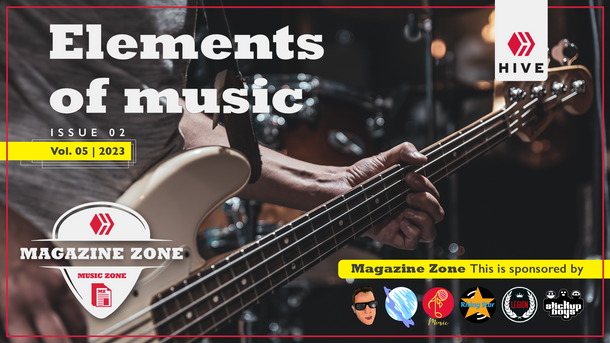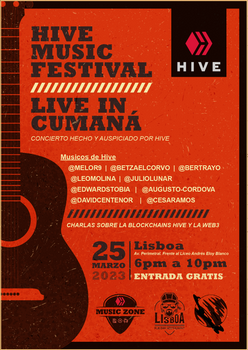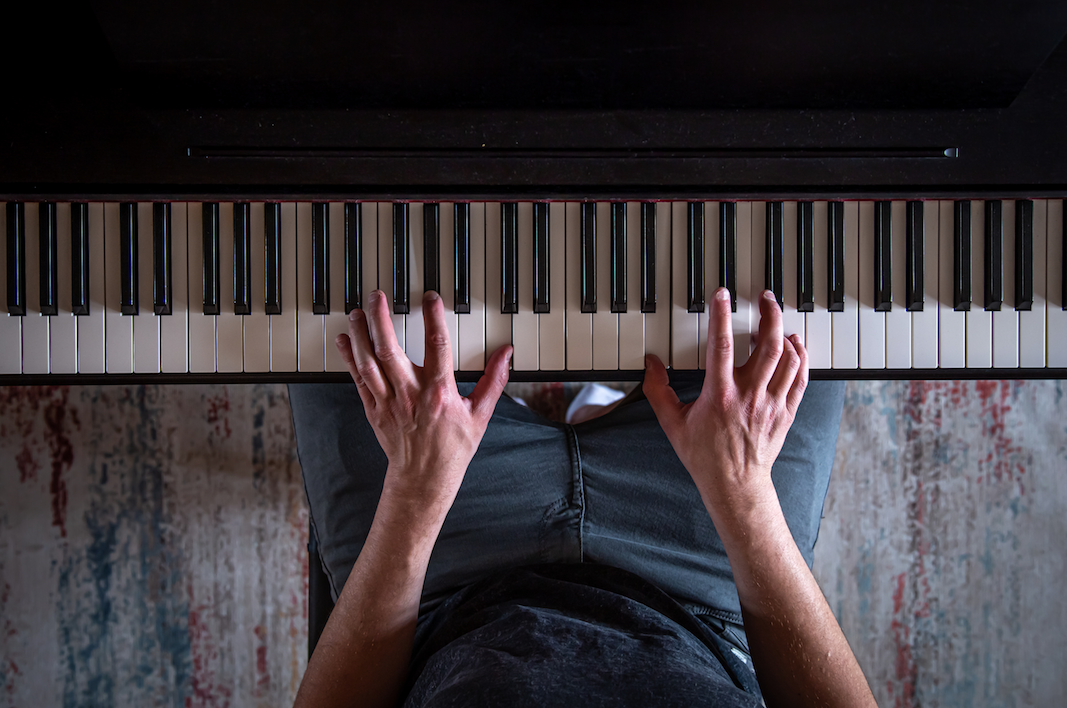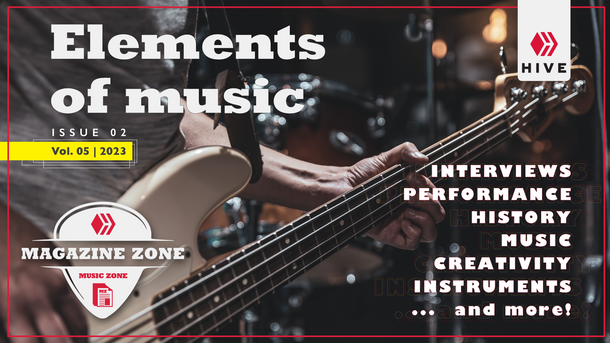
Source | Fuente
Elements of music
Elementos de la música
Art has the particularity of being free and having an almost infinite diversity, of course, we understand art as synonymous of creativity, so, what is crucial here is that each specific area of art has unique and specific elements. Although these elements are the same for everyone, much will depend on how they are used, this is where the creative factor of each person comes into play to make use of the available elements, not to mention that each artist has a particular perception of the world and the way they want to express their art. We have been able to realize that the results are inexhaustible, there are many different things that we see in the art world. In the case that concerns us, for music it is exactly the same, we have specific elements, available in equal measure to everyone, which can be used creatively to achieve a large number of unique works. The elements of music will dominate the expression, from rhythm, timbre and melody we can create a diversity of results. We know from the post on Musical Language that music has a language, that it is structured and, above all, that it has evolved; in the same way, the elements of music have their origins in prehistory.
El arte tiene la particularidad de ser libre y contar con una diversidad casi infinita, por supuesto, entendemos el arte como sinónimo de creatividad, por lo que, lo crucial acá es que cada área específica del arte posee elementos singulares y específicos. Aunque estos elementos sean iguales para todos, mucho dependerá de la manera en como se empleen, es aquí donde entra en juego el factor creativo de cada quien para hacer uso de los elementos disponibles, esto, sin mencionar que cada artista tiene una percepción particular del mundo y de la forma como deseo expresar su arte. Nos hemos podido dar cuenta que los resultados son inagotables, son muchas cosas distintas las que vemos dentro del mundo del arte. En el caso que nos concierne, para la música sucede exactamente igual, disponemos de elementos específicos, disponibles en igual medida para todos, los cuales se pueden utilizar de manera creativa para lograr una gran cantidad de obras únicas. Los elementos de la música dominarán la expresión, a partir de ritmo, el timbre y la melodía podremos crear diversidad de resultados. Sabemos del post sobre Lenguaje Musical que la música posee un lenguaje, que es estructurado y, que sobre todo, ha evolucionado; de la misma manera, los elementos de la música tienen sus orígenes en la prehistoria.
The Rhythm | El Ritmo

We will not know exactly when music as such appeared. Some people have speculated that rhythm was the first to appear. Rhythm may have appeared in prehistoric peoples when they stuck stones together, and so, with the passage of time, these populations may have understood that effect on people, in the same way that music does. Rhythm was invented and became our first musical element. So, what is rhythm?
Rhythm (masculine noun)
- The way in which a series of sounds that are repeated periodically in a given time interval follow one another and alternate, especially the way in which sounds that are different in intensity (loud and soft) or duration (long and short) follow one another and alternate in an artistic work. "the rhythm of the drums".
- The way in which a series of things (movements, palpitations, events, etc.) that are repeated periodically in a certain interval of time follow one another and alternate.
"only with the years can one perceive the rhythm of the seasons".
No sabremos con exactitud cuando apareció la música como tal. Algunas personas han podido especular que el ritmo fue el primero en aparecer. El ritmo pudo haber aparecido en los pueblos prehistóricos cuando pegaban piedras unas con otras, y así, con el paso del tiempo, estas poblaciones quizás fueron entendiendo ese efecto en las personas, de la misma manera como lo hace la música. El ritmo se inventaría y vendría siendo nuestro primer elemento musical. Entonces, ¿Qué es el ritmo?
Ritmo (nombre masculino)
1. Forma de sucederse y alternar una serie de sonidos que se repiten periódicamente en un determinado intervalo de tiempo, especialmente la manera en que se suceden y alternan en una obra artística los sonidos diferentes en intensidad (fuertes y débiles) o duración (largos y breves). "El ritmo de los tambores"
2. Forma de sucederse y alternar una serie de cosas (movimientos, palpitaciones, acontecimientos, etc.) que se repiten periódicamente en un determinado intervalo de tiempo. "Solo con los años se percibe el ritmo de las estaciones"

🔸


Rhythm is the sequence of sounds
in different periods of time,
where these are repeated
leaving a specific pattern.
El ritmo es la secuencia de sonidos
en periodos de tiempo diferentes,
donde estos se van repitiendo
dejando un patrón específico.

The Bell | El Timbre

Possibly, these people, from the use of stones, were able to discover the timbre with consequence to distinguish the different sounds. In this way, the timbre would be our second musical element. The timbre would be like the fingerprint of the sound, by which it is recognized and identified. For this reason, we can differentiate a guitar from a saxophone, for example. From this we can get creative and begin to understand that hitting a stone against a piece of stick does not produce the same sound as hitting stone against stone. The powerful example that comes to mind for this are the characters of Stomp, watch and listen, they are brilliant. Appreciate how they can have the ability to produce and understand in depth rhythm and timbre is very surprising, it's very nice. They give us a diversity of possibilities and our mind is blown with that incredible complexity, just using rhythm and timbre. This form of rhythmic-timbral music, as done by Stomp, gives us samples of the evolution of rhythm and timbre.
Posiblemente, estos pueblos, a partir del uso de las piedras, pudieron descubrir el timbre con consecuencia para distinguir los diferentes sonidos. De esta manera, el timbre vendría siendo nuestro segundo elemento musical. El timbre vendría siendo como la huella dactilar del sonido, por lo que se reconoce e identifica. Por esta razón, podemos diferenciar una guitarra de un saxofón, por ejemplo. A partir de esto podemos ponernos creativos y empezar a comprender que pegar una piedra a un pedazo de palo no produce el mismo sonido que pegar piedra contra piedra. El poderoso ejemplo que me viene a la mente para esto, son los personajes de Stomp, vean y escuchen, son brillantes. Apreciar como ellos pueden tener la capacidad de producir y comprender a profundidad el ritmo y el timbre es muy sorprendente, es muy agradable. Ellos nos dan una diversidad de posibilidades y nuestra mente se pone a volar con esa complejidad increíble, solamente usando el ritmo y el timbre. Esta forma de música rítmico-tímbrica, como la hace Stomp nos proporciona muestras de la evolución que ha tenido el ritmo y el timbre.

10.000 representaciones de STOMP

Pancakes 2: STOMP At Home



Source | Fuente
The Melody | La Melodía

On the other hand, we have one more element of the music, it would be our third musical element: The Melody. This element would be the most "pleasant" to the ear, and that is why many people take it as a criterion to judge the music (we could listen to what Stomp does without melody). The melody must also have appeared a great number of years ago, the peoples of prehistoric times surely realized that sounds had different heights, some low and some high, to produce melodies. As a consequence, they must have discovered notes, base sounds at different pitches. Instinctively, placing notes at different pitches, so that they would sound good, thus creating melodies; which physics has deepened with frequency and wave calculations. The notes that we are taught to sing from an early age, Do, Re, Mi, Fa, Sol, La, Si, Do, which are very familiar to us, are present in many cultures, although not always ordered in the same way. Finally, we can understand that we can build melodies, whose definition would be:
Melody (feminine noun)
- An orderly and coherent linear succession of musical sounds of different pitches that form a structured unit with musical meaning, independent of accompaniment.
"The constituent elements of music are rhythm, melody and harmony".- A succession of sounds that by the way they are combined is musical or pleasant to hear.
"From there one can only perceive the muffled melody of the wind among the myrtles".
Por otro lado, tenemos un elemento más de la música, sería nuestro tercer elemento musical: La Melodía. Este elemento vendría siendo el más "agradable" al oído, y por lo que muchas personas lo toman como criterio para juzgar a la música. (Pudimos escuchar lo que hace Stomp sin melodía). La melodía también debió aparecer hace una gran cantidad de años, los pueblos de la prehistoria seguramente se percataron de que los sonidos tenían diferentes alturas, unas graves y otras agudas, para producir melodías. Como consecuencia de ello, debieron haber descubierto las notas, sonidos bases a diferentes alturas. De manera instintiva, colocar notas a diferentes alturas, de manera que sonarán bien, creando así melodías; lo que la física ha profundizado con los cálculos de frecuencias y ondas. Las notas, que nos enseñan a cantar desde pequeños, Do, Re, Mi, Fa, Sol, La, Si, Do, que nos resultan muy familares, estan presenten en muchas culturas, aunque no siempre ordenadas de igual manera. Finalmente, podemos entender que podemos construir melodías, cuya definición sería:
Melodía (nombre femenino)
1. Sucesión lineal ordenada y coherente de sonidos musicales de diferente altura que forman una unidad estructurada con sentido musical, independiente del acompañamiento.
"Los elementos constitutivos de la música son el ritmo, la melodía y la armonía"
2. Sucesión de sonidos que por su manera de combinarse resulta musical o agradable de oír.
"Desde allí solamente se percibe la sorda melodía del viento entre los mirtos"

The melody is a sequence of notes
of different pitches, which have a constant or varied
rhythm and unique timbre,
different or combined.
La melodía es una secuencia de notas
de diferentes alturas, que tienen ritmo
constante o variado y timbre único,
distintos o combinados.

A word from Jesús
Unas palabras de Jesús

When we studied chemistry in school we learned that nature was made up of different elements and through the process of chemical reaction we experimented and discovered other substances. For this a catalyst is needed. Music is the result of the combination of different elements and the desire of mankind to communicate. Every morning we can listen to the song of the little birds, and we can know them and distinguish their species by their pitch. They do not all sing at the same frequency. Each one has a different imprint that makes them stand out. There is a blue whale that sings at a frequency of 52 hertz, it is known as the lone whale. They normally sing at a lower frequency. This sound is imperceptible to the human ear. Being different, and communicating on a different frequency, the other whales are unable to understand him. Imagine going around the world trying to shout and talk and no one listening to you. Like whales, humans speak and sing on different frequencies. It certainly requires great skill to recognize different frequencies and tonalities.
Cuando estudiamos química en la escuela aprendimos que la naturaleza estaba conformada por diferentes elementos y mediante el proceso de reacción química experimentamos y descubrimos otras sustancias. Para ello se necesita un catalizador. La música es el resultado de la combinación de diferentes elementos y del deseo de la humanidad de comunicarse. Cada mañana podemos escuchar el canto de los pajaritos, y podemos conocerlos y distinguir su especie por su tono. No todos cantan en la misma frecuencia. Cada uno tiene una huella diferente que los hace destacar. Hay una ballena azul que canta en una frecuencia de 52 hercios, se le conoce como la ballena solitaria. Estas normalmente cantan a una frecuencia menor. Este sonido es imperceptible para el oído humano. Al ser diferente, y comunicarse en otra frecuencia, las otras ballenas no logran entenderle. Imagínense ir por el mundo tratando de gritar y de hablar y que nadie te escuche. Al igual que las ballenas, los seres humanos hablamos y cantamos en diferentes frecuencias. Sin duda se requiere tener gran habilidad para reconocer diferentes frecuencias y tonalidades.

You may be interested in the story of the whale that sings at 52 Hertz, the loneliest whale in the world.
Te puede interesar la historia de la ballena que canta a 52 hercios, la mas solitaria del mundo.
Here | Aquí


Source | Fuente
Another quality of sound is the intensity or volume. There are songs that can be appreciated with an incredible force and others with a low volume sound. The degree of intensity can increase our adrenaline, and take us to moments of incredible euphoria. Of course, we must keep in mind that excesses are bad, an exaggerated volume can blow out our eardrums and damage our hearing system. High volume can cause a loss of focus on reality and reduce our sensitivity to soft things. Another important attribute is learning to differentiate between different instruments and voices. That quality is timbre. From birth we learn to recognize our mother by smell and timbre. These are unique characteristics of each person. As we develop as musicians, we can distinguish and recognize between a violin and a trumpet. Their sonorous imprint is different. It requires training the ear to identify the tonality, intensity and timbre.
Otra cualidad del sonido es la intensidad o volumen. Hay canciones que se pueden apreciar con una fuerza increíble y otras con un sonido bajo en volumen. El grado de intensidad puede incrementar nuestra adrenalina, y llevarnos a momentos de euforia increíbles. Claro, hay que tener en cuenta que los excesos son malos, un volumen exagerado puede volarnos los tímpanos y dañar nuestro aparato auditivo. El volumen alto puede causar una pérdida del enfoque de la realidad y mermar nuestra sensibilidad a las cosas suaves. Otro atributo importante es aprender a diferenciar los diferentes instrumentos y voces. Esa cualidad es el timbre. Desde que nacemos aprendemos a reconocer a nuestra madre por medio del olor y el timbre. Son características únicas de cada persona. A medida que nos vamos desarrollando como músicos, podemos distinguir y reconocer entre un violín y una trompeta. Su huella sonora es diferente. Se requiere entrenar el oído para identificar la tonalidad, la intensidad y el timbre.
Part of the process of becoming a musician is learning to recognize elements such as rhythm, melody and harmony. There are people who have an absolute ear, and can recognize notes at amazing distances. Others are skilled with rhythm. These abilities will depend on the world in which they develop. There is genetic information passed down from generation to generation, others of us are influenced by the different artistic manifestations of our communities. Some children have an innate gift for percussion instruments. Their process is simple, observe and imitate. Rhythm is an essential part of human beings, even the way we walk and the heart has a pulse, which means there is life. Other aspects have to do with the metric unit of time, with accents, time and duration. An additional element that should be contemplated is the ether, the spiritual dimension, the soul of music. That powerful force that inspires and motivates us to mix the essential components.
Parte del proceso de llegar a ser músico es aprender a reconocer elementos como el ritmo, la melodía y la armonía. Existen personas que tienen un oído absoluto, y pueden reconocer notas a distancias asombrosas. Otras tienen habilidades con el ritmo. Estas habilidades dependerán del mundo en que se desarrollan. Existe una información genética transmitida de generación en generación, otros nos vemos influenciados por las diferentes manifestaciones artísticas de nuestras comunidades. Algunos niños tienen un don innato para los instrumentos de percusión. Su proceso es sencillo, observar e imitar. El ritmo es una parte esencial de los seres humanos, hasta el modo de caminar y el corazón tiene su pulso, lo cual significa que hay vida. Otros aspectos tienen que ver con la unidad métrica de tiempo, con las acentuaciones, el tiempo y la duración. Un elemento adicional que debería contemplarse es el éter, la dimensión espiritual, el alma de la música. Esa fuerza poderosa que inspira y nos motiva para mezclar los componentes esenciales.

🔸


We invite you! | Te invitamos

Music Zone
©2023 - Todos los derechos reservados
©2023 - Todos los derechos reservados







~~~ embed:1638572914361368576 twitter metadata:MTYxNDc1NDA2OTIyNjA2MTgyNHx8aHR0cHM6Ly90d2l0dGVyLmNvbS8xNjE0NzU0MDY5MjI2MDYxODI0L3N0YXR1cy8xNjM4NTcyOTE0MzYxMzY4NTc2fA== ~~~
~~~ embed:1638682572766019585 twitter metadata:ODA0MjkzNzF8fGh0dHBzOi8vdHdpdHRlci5jb20vODA0MjkzNzEvc3RhdHVzLzE2Mzg2ODI1NzI3NjYwMTk1ODV8 ~~~
The rewards earned on this comment will go directly to the people( @edwardstobia, @yisusth, @augusto-cordova ) sharing the post on Twitter as long as they are registered with @poshtoken. Sign up at https://hiveposh.com.
Mi admiración y respeto por cada uno de los que aportan para el conocimiento de la comunidad, me parece fascinante el trabajo que hacen semana tras semana.
Bravo 👏
Agradecemos tu gran apoyo a esta comunidad, nos alegra tenerte por acá, también este logro se les debe a ustedes. Gracias por tus palabras.
Saludos
Excelente artículo chicos, un tema muy interesante, el caso de la ballena sola a cautivado y generado a la vez estudios más profundos con respecto al mecanismo de comunicación entre los cetáceos. Un gran aporte a la comunidad, felicidades @hectgranate y @yisusth 👍🏼
Muchas gracias. Saludos.@artefactoestudio, nos alegra que te haya gustado el tema, agradecemos tu valoración.
Muchas gracias por pasar y por el apoyo...
Saludos y un gran abrazo.
Muchísimas gracias. Estoy seguro que esta experiencia despertara la curiosidad de muchos. Gracias al equipo de @artefactoestudio 🎶🎺👏🏼👏🏼👏🏼
Magnifico!! Me encanta lo que en equipo somos capaces de lograr. Me agradó conocer un poco más sobre la música y sus elementos. Brillante manera de educarnos un poco más sobre este maravilloso arte que tanto amamos y nos une. Los felicito, sigan así... Bravo!
Nos alegra que este contenido te haya agradado y te ayude a creer.
Gracias por valorar esta educación que impartimos con mucho respeto.
SaludosTotalmente de acuerdo @edwardstobia, el trabajo en equipo siempre da grandes y gloriosos resultados.
Que maravillosa experiencia. Felicidades al equipo de Music Zone por el fantastico aporte que han realizado para la publicación de la revista musical semanal. No solo aprenderán los lectores, sino también los que estamos envueltos en este proyecto. Esperamos que sea una herramienta para el crecimiento profesional y personal. Seguimos adelante.
Saludos @yisusth, ha sido un gusto y un honor para nosotros leer tus palabras en #magazinezone nuevamente. Gracias pro todo tu apoyo.
Maravilloso, se sigue avanzando en esta proyecto que tiene muy buen potencial.
Saludos Gracias por la colaboración @yisusth y por el apoyo.
Estimado @hectgranate, es un honor trabajar al lado de un equipo tan genial como ustedes.
Seguimos creciendo y aprendiendo. Saludos hermano.
Saludos@hectgranate, muchas gracias por tus aportes y buena energía con esta labor que haces en el Magazone. Felicidades.
Congratulations @musiczone! You have completed the following achievement on the Hive blockchain And have been rewarded with New badge(s)
Your next target is to reach 500 upvotes.
You can view your badges on your board and compare yourself to others in the Ranking
If you no longer want to receive notifications, reply to this comment with the word
STOPTo support your work, I also upvoted your post!
Check out our last posts:
Support the HiveBuzz project. Vote for our proposal!